Case Study Analysis: Mrs. Bacci's Diabetic Foot Ulcer, NRSG258 Module
VerifiedAdded on 2023/01/10
|10
|2527
|2
Case Study
AI Summary
This case study focuses on Mrs. Gina Bacci, a 49-year-old Italian woman with type 2 diabetes, peripheral vascular disease, and obesity, who presented with a right foot ulcer leading to partial amputation. The assignment analyzes her condition, including her medical history, current medications, and physical assessment findings such as blood glucose levels, wound characteristics, and peripheral circulation. It explores the pathophysiology of diabetic foot ulcers, emphasizing the impact of diabetes and peripheral vascular disease on wound healing and infection risk. The case study identifies nursing priorities, including maintaining tissue integrity and controlling blood sugar levels. It details nursing management strategies, such as wound care, pain management, medication adherence, and patient education, as well as continuous monitoring of comorbidities like diabetes and peripheral vascular disease. The document emphasizes the importance of a multidisciplinary approach and patient education to reduce mortality rates and enhance the patient's quality of life. The references include sources from American Diabetes Association and Australian Wound Management Association.

CASE STUDY 1
Name:
Institutional affiliation:
Name:
Institutional affiliation:
Paraphrase This Document
Need a fresh take? Get an instant paraphrase of this document with our AI Paraphraser
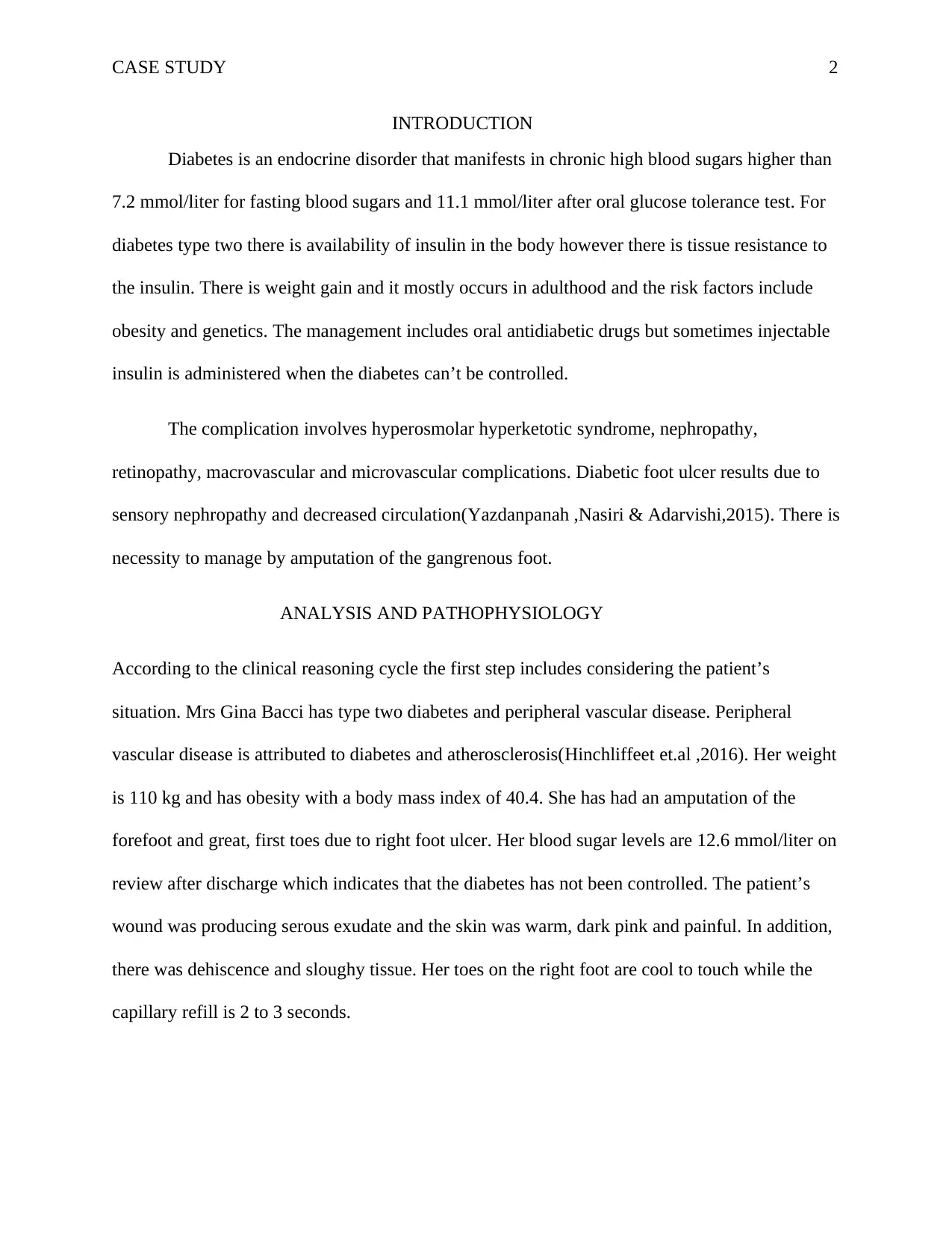
CASE STUDY 2
INTRODUCTION
Diabetes is an endocrine disorder that manifests in chronic high blood sugars higher than
7.2 mmol/liter for fasting blood sugars and 11.1 mmol/liter after oral glucose tolerance test. For
diabetes type two there is availability of insulin in the body however there is tissue resistance to
the insulin. There is weight gain and it mostly occurs in adulthood and the risk factors include
obesity and genetics. The management includes oral antidiabetic drugs but sometimes injectable
insulin is administered when the diabetes can’t be controlled.
The complication involves hyperosmolar hyperketotic syndrome, nephropathy,
retinopathy, macrovascular and microvascular complications. Diabetic foot ulcer results due to
sensory nephropathy and decreased circulation(Yazdanpanah ,Nasiri & Adarvishi,2015). There is
necessity to manage by amputation of the gangrenous foot.
ANALYSIS AND PATHOPHYSIOLOGY
According to the clinical reasoning cycle the first step includes considering the patient’s
situation. Mrs Gina Bacci has type two diabetes and peripheral vascular disease. Peripheral
vascular disease is attributed to diabetes and atherosclerosis(Hinchliffeet et.al ,2016). Her weight
is 110 kg and has obesity with a body mass index of 40.4. She has had an amputation of the
forefoot and great, first toes due to right foot ulcer. Her blood sugar levels are 12.6 mmol/liter on
review after discharge which indicates that the diabetes has not been controlled. The patient’s
wound was producing serous exudate and the skin was warm, dark pink and painful. In addition,
there was dehiscence and sloughy tissue. Her toes on the right foot are cool to touch while the
capillary refill is 2 to 3 seconds.
INTRODUCTION
Diabetes is an endocrine disorder that manifests in chronic high blood sugars higher than
7.2 mmol/liter for fasting blood sugars and 11.1 mmol/liter after oral glucose tolerance test. For
diabetes type two there is availability of insulin in the body however there is tissue resistance to
the insulin. There is weight gain and it mostly occurs in adulthood and the risk factors include
obesity and genetics. The management includes oral antidiabetic drugs but sometimes injectable
insulin is administered when the diabetes can’t be controlled.
The complication involves hyperosmolar hyperketotic syndrome, nephropathy,
retinopathy, macrovascular and microvascular complications. Diabetic foot ulcer results due to
sensory nephropathy and decreased circulation(Yazdanpanah ,Nasiri & Adarvishi,2015). There is
necessity to manage by amputation of the gangrenous foot.
ANALYSIS AND PATHOPHYSIOLOGY
According to the clinical reasoning cycle the first step includes considering the patient’s
situation. Mrs Gina Bacci has type two diabetes and peripheral vascular disease. Peripheral
vascular disease is attributed to diabetes and atherosclerosis(Hinchliffeet et.al ,2016). Her weight
is 110 kg and has obesity with a body mass index of 40.4. She has had an amputation of the
forefoot and great, first toes due to right foot ulcer. Her blood sugar levels are 12.6 mmol/liter on
review after discharge which indicates that the diabetes has not been controlled. The patient’s
wound was producing serous exudate and the skin was warm, dark pink and painful. In addition,
there was dehiscence and sloughy tissue. Her toes on the right foot are cool to touch while the
capillary refill is 2 to 3 seconds.
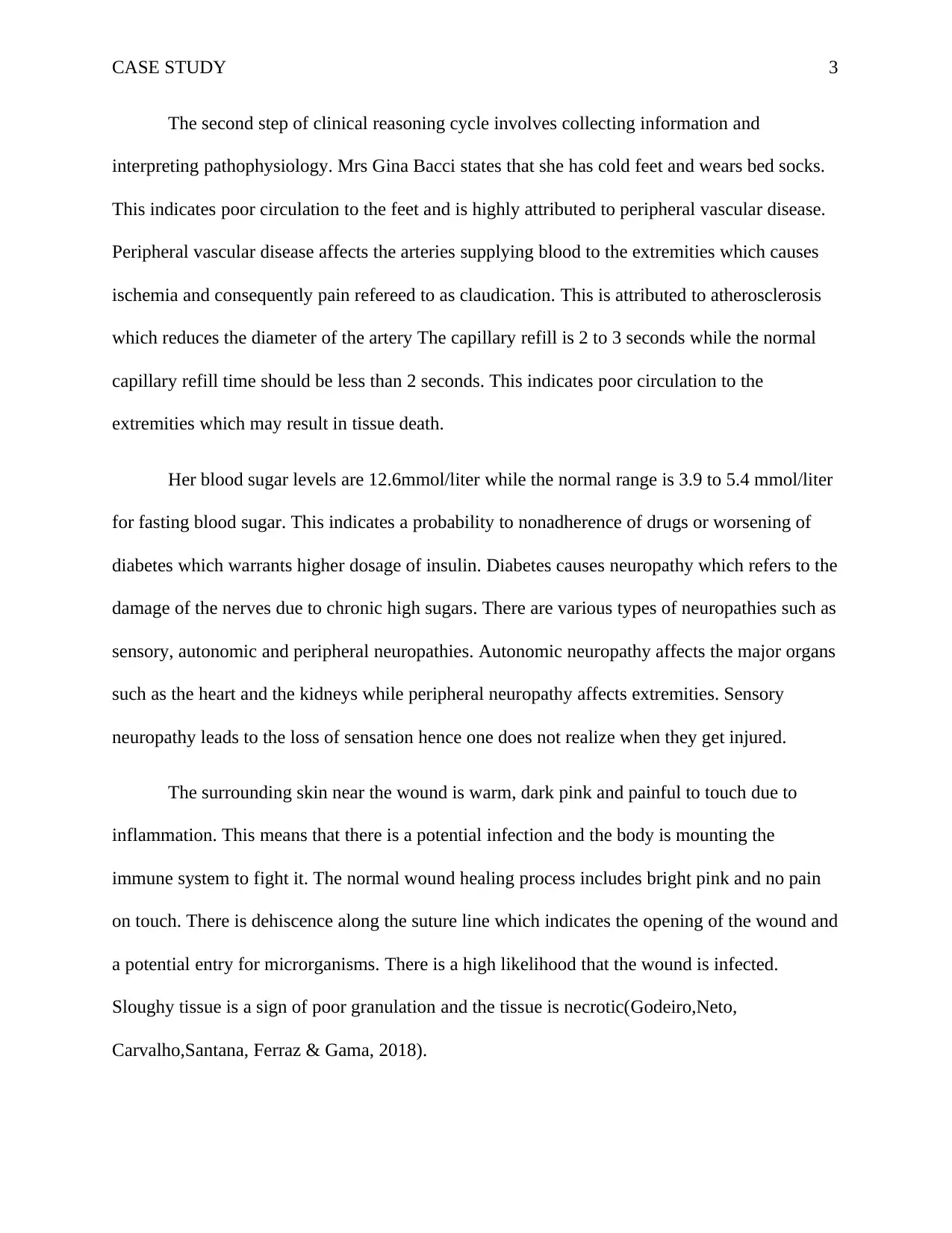
CASE STUDY 3
The second step of clinical reasoning cycle involves collecting information and
interpreting pathophysiology. Mrs Gina Bacci states that she has cold feet and wears bed socks.
This indicates poor circulation to the feet and is highly attributed to peripheral vascular disease.
Peripheral vascular disease affects the arteries supplying blood to the extremities which causes
ischemia and consequently pain refereed to as claudication. This is attributed to atherosclerosis
which reduces the diameter of the artery The capillary refill is 2 to 3 seconds while the normal
capillary refill time should be less than 2 seconds. This indicates poor circulation to the
extremities which may result in tissue death.
Her blood sugar levels are 12.6mmol/liter while the normal range is 3.9 to 5.4 mmol/liter
for fasting blood sugar. This indicates a probability to nonadherence of drugs or worsening of
diabetes which warrants higher dosage of insulin. Diabetes causes neuropathy which refers to the
damage of the nerves due to chronic high sugars. There are various types of neuropathies such as
sensory, autonomic and peripheral neuropathies. Autonomic neuropathy affects the major organs
such as the heart and the kidneys while peripheral neuropathy affects extremities. Sensory
neuropathy leads to the loss of sensation hence one does not realize when they get injured.
The surrounding skin near the wound is warm, dark pink and painful to touch due to
inflammation. This means that there is a potential infection and the body is mounting the
immune system to fight it. The normal wound healing process includes bright pink and no pain
on touch. There is dehiscence along the suture line which indicates the opening of the wound and
a potential entry for microrganisms. There is a high likelihood that the wound is infected.
Sloughy tissue is a sign of poor granulation and the tissue is necrotic(Godeiro,Neto,
Carvalho,Santana, Ferraz & Gama, 2018).
The second step of clinical reasoning cycle involves collecting information and
interpreting pathophysiology. Mrs Gina Bacci states that she has cold feet and wears bed socks.
This indicates poor circulation to the feet and is highly attributed to peripheral vascular disease.
Peripheral vascular disease affects the arteries supplying blood to the extremities which causes
ischemia and consequently pain refereed to as claudication. This is attributed to atherosclerosis
which reduces the diameter of the artery The capillary refill is 2 to 3 seconds while the normal
capillary refill time should be less than 2 seconds. This indicates poor circulation to the
extremities which may result in tissue death.
Her blood sugar levels are 12.6mmol/liter while the normal range is 3.9 to 5.4 mmol/liter
for fasting blood sugar. This indicates a probability to nonadherence of drugs or worsening of
diabetes which warrants higher dosage of insulin. Diabetes causes neuropathy which refers to the
damage of the nerves due to chronic high sugars. There are various types of neuropathies such as
sensory, autonomic and peripheral neuropathies. Autonomic neuropathy affects the major organs
such as the heart and the kidneys while peripheral neuropathy affects extremities. Sensory
neuropathy leads to the loss of sensation hence one does not realize when they get injured.
The surrounding skin near the wound is warm, dark pink and painful to touch due to
inflammation. This means that there is a potential infection and the body is mounting the
immune system to fight it. The normal wound healing process includes bright pink and no pain
on touch. There is dehiscence along the suture line which indicates the opening of the wound and
a potential entry for microrganisms. There is a high likelihood that the wound is infected.
Sloughy tissue is a sign of poor granulation and the tissue is necrotic(Godeiro,Neto,
Carvalho,Santana, Ferraz & Gama, 2018).
⊘ This is a preview!⊘
Do you want full access?
Subscribe today to unlock all pages.

Trusted by 1+ million students worldwide

CASE STUDY 4
The pathophysiology surrounding this wound status is peripheral vascular disease which
results in decreased circulation to the extremities. The proliferative phase of wound healing
which is approximately 4 days after incision requires development of capillaries. However
peripheral vascular limits the amount of blood to the wound and therefore ischemia. The patient
has high blood sugars which leads to low resistance to infection due to immunocompromise.
Hyperglycemia causes decreased ability of leukocytes to phagocytose debris and infectious
microorganisms. Furthermore, neuropathy leads to reduced sensation to pain hence inability to
give feedback. The patient is on insulin aspart, insulin glargine, pregabalin and paracetamol.
The third step is making new inferences and form opinions. There is a possible infection
on the postoperative wound due to pre-existing conditions such as diabetes and peripheral
vascular disease. The interpretation of this case is that the Mrs Gina Bacci needs urgent medical
attention. Peripheral vascular disease worsens the situation as diabetes affects blood vessels as
the high blood sugars affects the endothelial layer which results in vasoconstriction and
decreased circulation(American Diabetes Association,2016)
NURSING PRIORITIES
Step four of clinical reasoning cycle involves identifying a problem that requires urgent
nursing care. Mrs Ginna Bacci has a wound and along the suture line there is dehiscence. This is
a break into the wound and is a potential source of infection for the patient. There is need to
protect the patient from infection and accelerate healing as quickly as possible. However, all
these can only be done if the diabetes and peripheral vascular disease are under control. The first
nursing priority is maintaining tissue integrity. This is done in collaboration with the physician
who examines the extent of sloughy tissue and dehiscence that has occurred. There is need to
The pathophysiology surrounding this wound status is peripheral vascular disease which
results in decreased circulation to the extremities. The proliferative phase of wound healing
which is approximately 4 days after incision requires development of capillaries. However
peripheral vascular limits the amount of blood to the wound and therefore ischemia. The patient
has high blood sugars which leads to low resistance to infection due to immunocompromise.
Hyperglycemia causes decreased ability of leukocytes to phagocytose debris and infectious
microorganisms. Furthermore, neuropathy leads to reduced sensation to pain hence inability to
give feedback. The patient is on insulin aspart, insulin glargine, pregabalin and paracetamol.
The third step is making new inferences and form opinions. There is a possible infection
on the postoperative wound due to pre-existing conditions such as diabetes and peripheral
vascular disease. The interpretation of this case is that the Mrs Gina Bacci needs urgent medical
attention. Peripheral vascular disease worsens the situation as diabetes affects blood vessels as
the high blood sugars affects the endothelial layer which results in vasoconstriction and
decreased circulation(American Diabetes Association,2016)
NURSING PRIORITIES
Step four of clinical reasoning cycle involves identifying a problem that requires urgent
nursing care. Mrs Ginna Bacci has a wound and along the suture line there is dehiscence. This is
a break into the wound and is a potential source of infection for the patient. There is need to
protect the patient from infection and accelerate healing as quickly as possible. However, all
these can only be done if the diabetes and peripheral vascular disease are under control. The first
nursing priority is maintaining tissue integrity. This is done in collaboration with the physician
who examines the extent of sloughy tissue and dehiscence that has occurred. There is need to
Paraphrase This Document
Need a fresh take? Get an instant paraphrase of this document with our AI Paraphraser
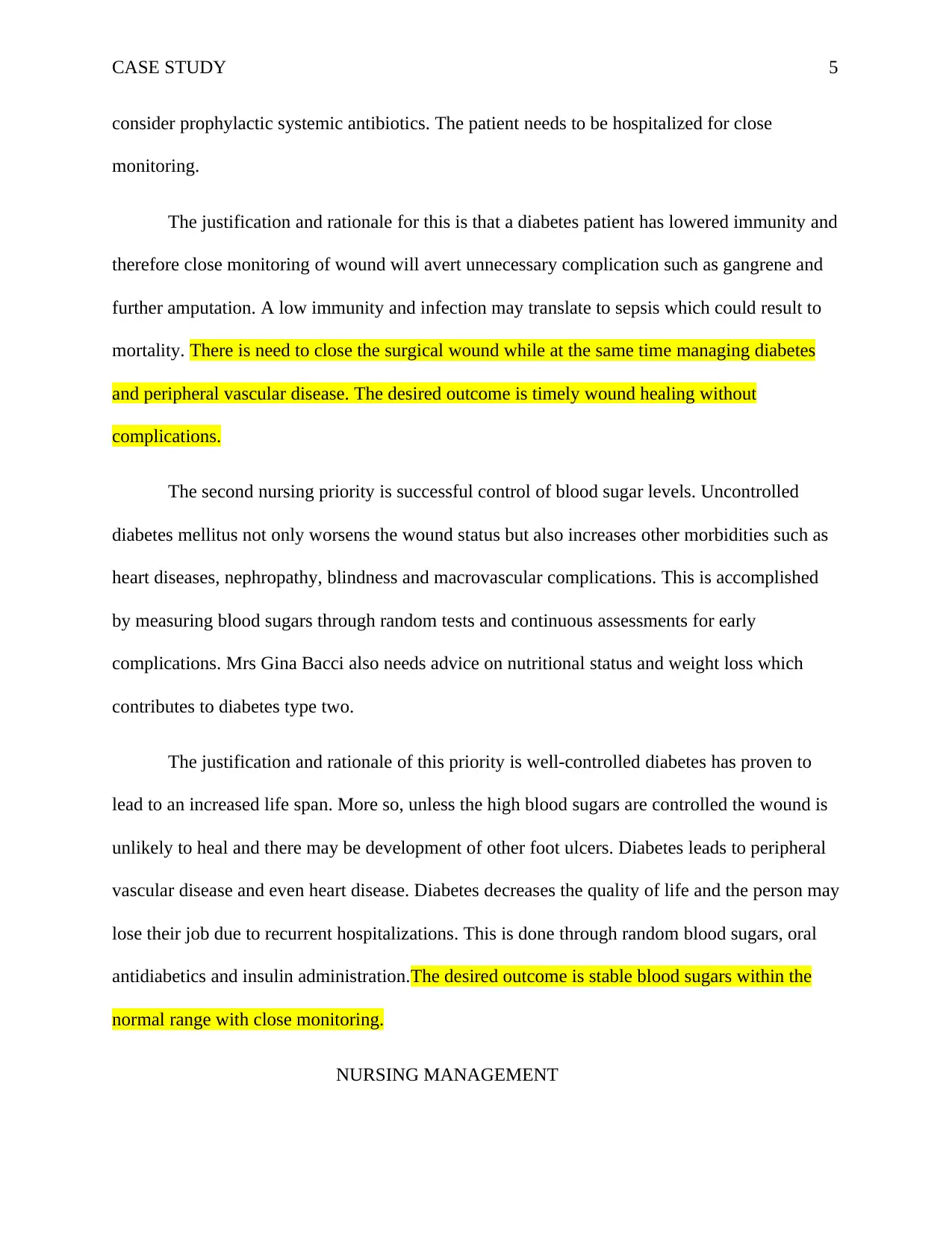
CASE STUDY 5
consider prophylactic systemic antibiotics. The patient needs to be hospitalized for close
monitoring.
The justification and rationale for this is that a diabetes patient has lowered immunity and
therefore close monitoring of wound will avert unnecessary complication such as gangrene and
further amputation. A low immunity and infection may translate to sepsis which could result to
mortality. There is need to close the surgical wound while at the same time managing diabetes
and peripheral vascular disease. The desired outcome is timely wound healing without
complications.
The second nursing priority is successful control of blood sugar levels. Uncontrolled
diabetes mellitus not only worsens the wound status but also increases other morbidities such as
heart diseases, nephropathy, blindness and macrovascular complications. This is accomplished
by measuring blood sugars through random tests and continuous assessments for early
complications. Mrs Gina Bacci also needs advice on nutritional status and weight loss which
contributes to diabetes type two.
The justification and rationale of this priority is well-controlled diabetes has proven to
lead to an increased life span. More so, unless the high blood sugars are controlled the wound is
unlikely to heal and there may be development of other foot ulcers. Diabetes leads to peripheral
vascular disease and even heart disease. Diabetes decreases the quality of life and the person may
lose their job due to recurrent hospitalizations. This is done through random blood sugars, oral
antidiabetics and insulin administration.The desired outcome is stable blood sugars within the
normal range with close monitoring.
NURSING MANAGEMENT
consider prophylactic systemic antibiotics. The patient needs to be hospitalized for close
monitoring.
The justification and rationale for this is that a diabetes patient has lowered immunity and
therefore close monitoring of wound will avert unnecessary complication such as gangrene and
further amputation. A low immunity and infection may translate to sepsis which could result to
mortality. There is need to close the surgical wound while at the same time managing diabetes
and peripheral vascular disease. The desired outcome is timely wound healing without
complications.
The second nursing priority is successful control of blood sugar levels. Uncontrolled
diabetes mellitus not only worsens the wound status but also increases other morbidities such as
heart diseases, nephropathy, blindness and macrovascular complications. This is accomplished
by measuring blood sugars through random tests and continuous assessments for early
complications. Mrs Gina Bacci also needs advice on nutritional status and weight loss which
contributes to diabetes type two.
The justification and rationale of this priority is well-controlled diabetes has proven to
lead to an increased life span. More so, unless the high blood sugars are controlled the wound is
unlikely to heal and there may be development of other foot ulcers. Diabetes leads to peripheral
vascular disease and even heart disease. Diabetes decreases the quality of life and the person may
lose their job due to recurrent hospitalizations. This is done through random blood sugars, oral
antidiabetics and insulin administration.The desired outcome is stable blood sugars within the
normal range with close monitoring.
NURSING MANAGEMENT
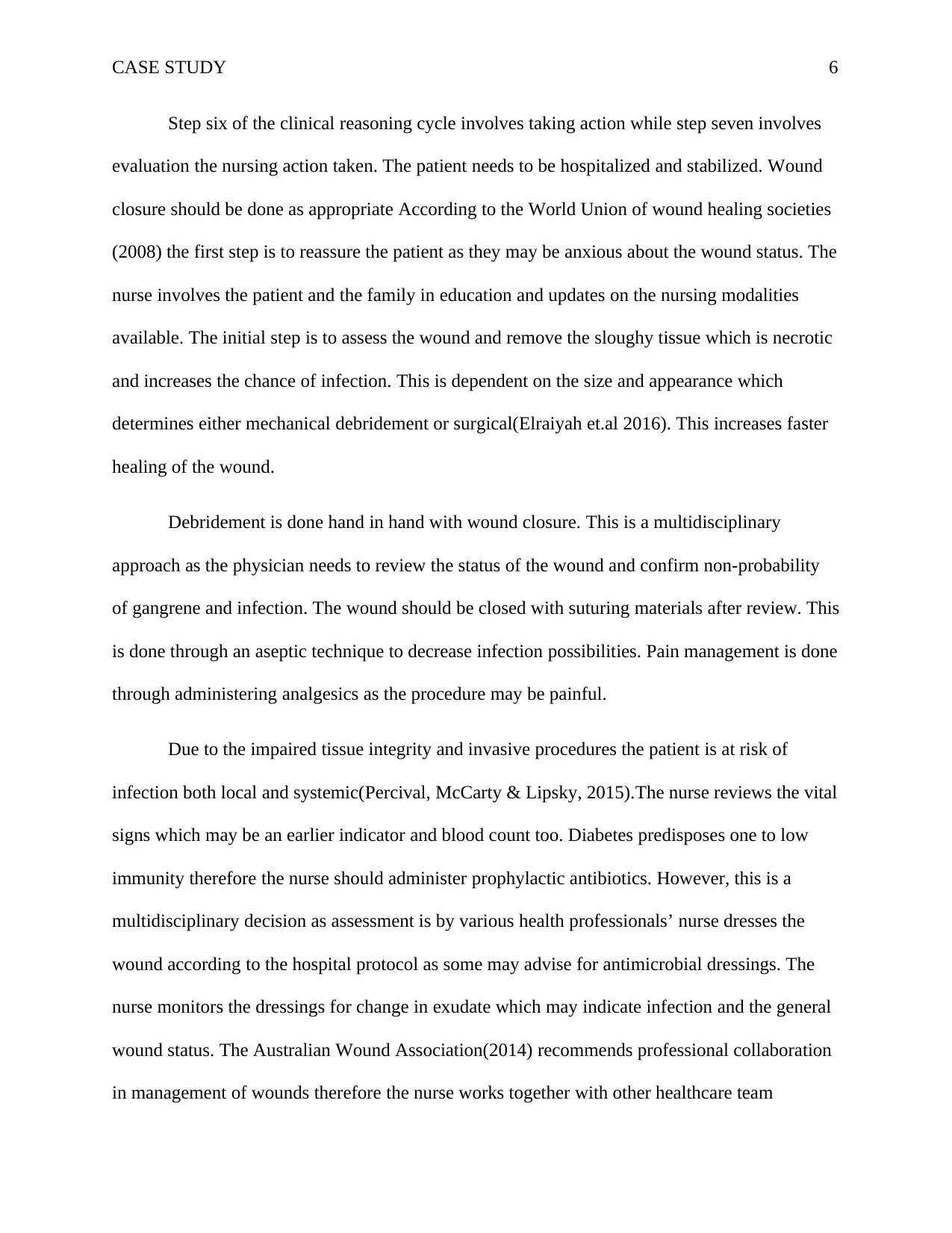
CASE STUDY 6
Step six of the clinical reasoning cycle involves taking action while step seven involves
evaluation the nursing action taken. The patient needs to be hospitalized and stabilized. Wound
closure should be done as appropriate According to the World Union of wound healing societies
(2008) the first step is to reassure the patient as they may be anxious about the wound status. The
nurse involves the patient and the family in education and updates on the nursing modalities
available. The initial step is to assess the wound and remove the sloughy tissue which is necrotic
and increases the chance of infection. This is dependent on the size and appearance which
determines either mechanical debridement or surgical(Elraiyah et.al 2016). This increases faster
healing of the wound.
Debridement is done hand in hand with wound closure. This is a multidisciplinary
approach as the physician needs to review the status of the wound and confirm non-probability
of gangrene and infection. The wound should be closed with suturing materials after review. This
is done through an aseptic technique to decrease infection possibilities. Pain management is done
through administering analgesics as the procedure may be painful.
Due to the impaired tissue integrity and invasive procedures the patient is at risk of
infection both local and systemic(Percival, McCarty & Lipsky, 2015).The nurse reviews the vital
signs which may be an earlier indicator and blood count too. Diabetes predisposes one to low
immunity therefore the nurse should administer prophylactic antibiotics. However, this is a
multidisciplinary decision as assessment is by various health professionals’ nurse dresses the
wound according to the hospital protocol as some may advise for antimicrobial dressings. The
nurse monitors the dressings for change in exudate which may indicate infection and the general
wound status. The Australian Wound Association(2014) recommends professional collaboration
in management of wounds therefore the nurse works together with other healthcare team
Step six of the clinical reasoning cycle involves taking action while step seven involves
evaluation the nursing action taken. The patient needs to be hospitalized and stabilized. Wound
closure should be done as appropriate According to the World Union of wound healing societies
(2008) the first step is to reassure the patient as they may be anxious about the wound status. The
nurse involves the patient and the family in education and updates on the nursing modalities
available. The initial step is to assess the wound and remove the sloughy tissue which is necrotic
and increases the chance of infection. This is dependent on the size and appearance which
determines either mechanical debridement or surgical(Elraiyah et.al 2016). This increases faster
healing of the wound.
Debridement is done hand in hand with wound closure. This is a multidisciplinary
approach as the physician needs to review the status of the wound and confirm non-probability
of gangrene and infection. The wound should be closed with suturing materials after review. This
is done through an aseptic technique to decrease infection possibilities. Pain management is done
through administering analgesics as the procedure may be painful.
Due to the impaired tissue integrity and invasive procedures the patient is at risk of
infection both local and systemic(Percival, McCarty & Lipsky, 2015).The nurse reviews the vital
signs which may be an earlier indicator and blood count too. Diabetes predisposes one to low
immunity therefore the nurse should administer prophylactic antibiotics. However, this is a
multidisciplinary decision as assessment is by various health professionals’ nurse dresses the
wound according to the hospital protocol as some may advise for antimicrobial dressings. The
nurse monitors the dressings for change in exudate which may indicate infection and the general
wound status. The Australian Wound Association(2014) recommends professional collaboration
in management of wounds therefore the nurse works together with other healthcare team
⊘ This is a preview!⊘
Do you want full access?
Subscribe today to unlock all pages.

Trusted by 1+ million students worldwide
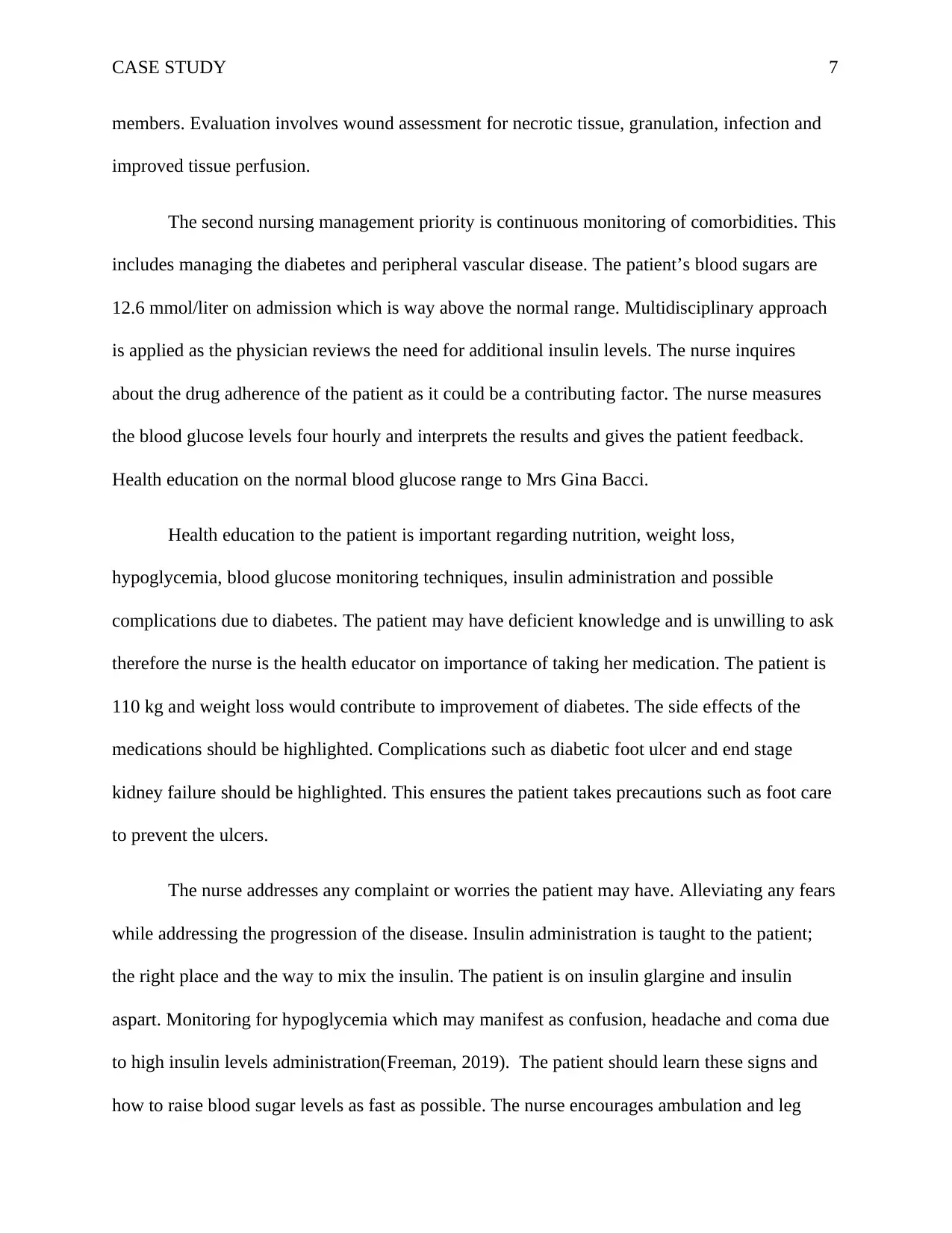
CASE STUDY 7
members. Evaluation involves wound assessment for necrotic tissue, granulation, infection and
improved tissue perfusion.
The second nursing management priority is continuous monitoring of comorbidities. This
includes managing the diabetes and peripheral vascular disease. The patient’s blood sugars are
12.6 mmol/liter on admission which is way above the normal range. Multidisciplinary approach
is applied as the physician reviews the need for additional insulin levels. The nurse inquires
about the drug adherence of the patient as it could be a contributing factor. The nurse measures
the blood glucose levels four hourly and interprets the results and gives the patient feedback.
Health education on the normal blood glucose range to Mrs Gina Bacci.
Health education to the patient is important regarding nutrition, weight loss,
hypoglycemia, blood glucose monitoring techniques, insulin administration and possible
complications due to diabetes. The patient may have deficient knowledge and is unwilling to ask
therefore the nurse is the health educator on importance of taking her medication. The patient is
110 kg and weight loss would contribute to improvement of diabetes. The side effects of the
medications should be highlighted. Complications such as diabetic foot ulcer and end stage
kidney failure should be highlighted. This ensures the patient takes precautions such as foot care
to prevent the ulcers.
The nurse addresses any complaint or worries the patient may have. Alleviating any fears
while addressing the progression of the disease. Insulin administration is taught to the patient;
the right place and the way to mix the insulin. The patient is on insulin glargine and insulin
aspart. Monitoring for hypoglycemia which may manifest as confusion, headache and coma due
to high insulin levels administration(Freeman, 2019). The patient should learn these signs and
how to raise blood sugar levels as fast as possible. The nurse encourages ambulation and leg
members. Evaluation involves wound assessment for necrotic tissue, granulation, infection and
improved tissue perfusion.
The second nursing management priority is continuous monitoring of comorbidities. This
includes managing the diabetes and peripheral vascular disease. The patient’s blood sugars are
12.6 mmol/liter on admission which is way above the normal range. Multidisciplinary approach
is applied as the physician reviews the need for additional insulin levels. The nurse inquires
about the drug adherence of the patient as it could be a contributing factor. The nurse measures
the blood glucose levels four hourly and interprets the results and gives the patient feedback.
Health education on the normal blood glucose range to Mrs Gina Bacci.
Health education to the patient is important regarding nutrition, weight loss,
hypoglycemia, blood glucose monitoring techniques, insulin administration and possible
complications due to diabetes. The patient may have deficient knowledge and is unwilling to ask
therefore the nurse is the health educator on importance of taking her medication. The patient is
110 kg and weight loss would contribute to improvement of diabetes. The side effects of the
medications should be highlighted. Complications such as diabetic foot ulcer and end stage
kidney failure should be highlighted. This ensures the patient takes precautions such as foot care
to prevent the ulcers.
The nurse addresses any complaint or worries the patient may have. Alleviating any fears
while addressing the progression of the disease. Insulin administration is taught to the patient;
the right place and the way to mix the insulin. The patient is on insulin glargine and insulin
aspart. Monitoring for hypoglycemia which may manifest as confusion, headache and coma due
to high insulin levels administration(Freeman, 2019). The patient should learn these signs and
how to raise blood sugar levels as fast as possible. The nurse encourages ambulation and leg
Paraphrase This Document
Need a fresh take? Get an instant paraphrase of this document with our AI Paraphraser
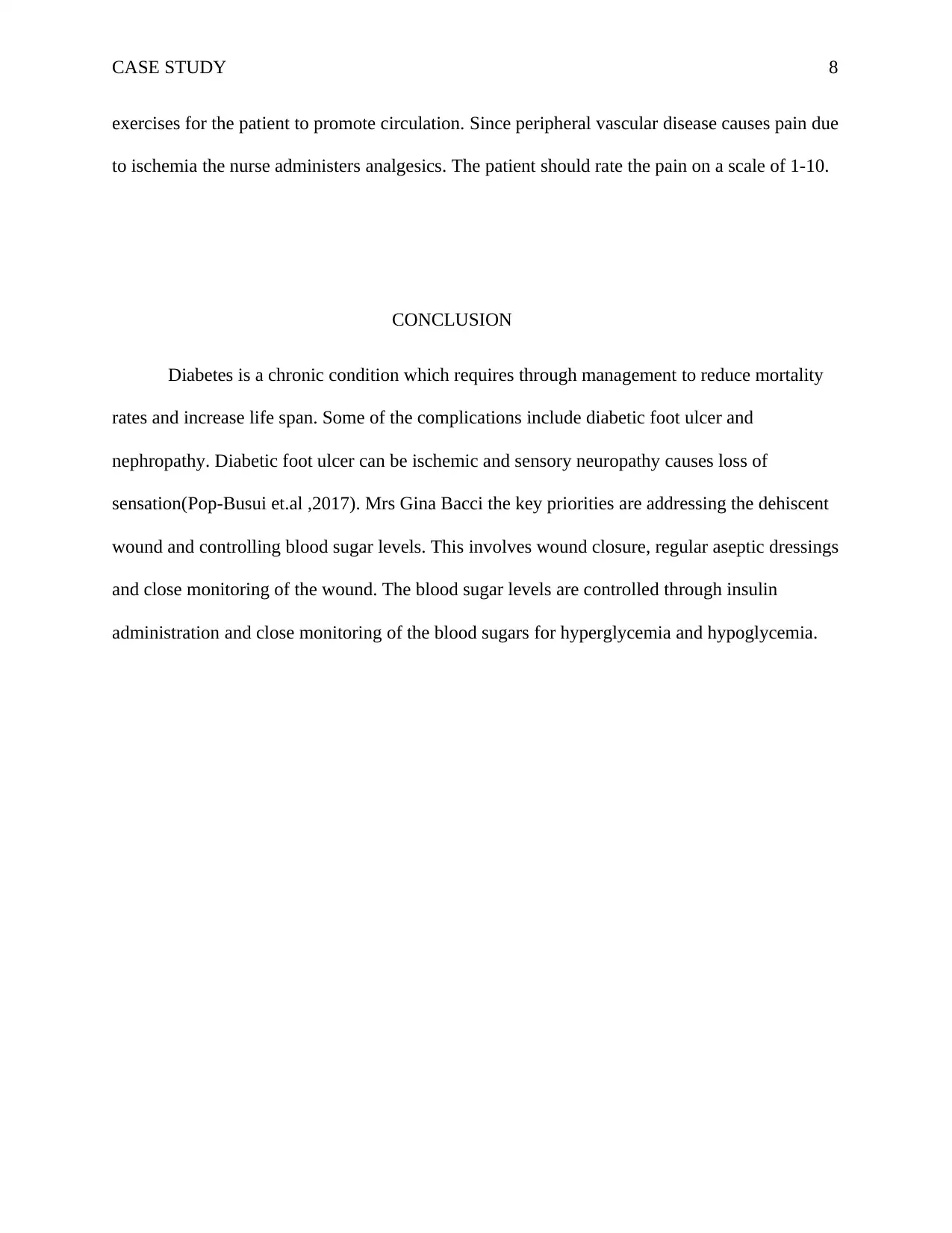
CASE STUDY 8
exercises for the patient to promote circulation. Since peripheral vascular disease causes pain due
to ischemia the nurse administers analgesics. The patient should rate the pain on a scale of 1-10.
CONCLUSION
Diabetes is a chronic condition which requires through management to reduce mortality
rates and increase life span. Some of the complications include diabetic foot ulcer and
nephropathy. Diabetic foot ulcer can be ischemic and sensory neuropathy causes loss of
sensation(Pop-Busui et.al ,2017). Mrs Gina Bacci the key priorities are addressing the dehiscent
wound and controlling blood sugar levels. This involves wound closure, regular aseptic dressings
and close monitoring of the wound. The blood sugar levels are controlled through insulin
administration and close monitoring of the blood sugars for hyperglycemia and hypoglycemia.
exercises for the patient to promote circulation. Since peripheral vascular disease causes pain due
to ischemia the nurse administers analgesics. The patient should rate the pain on a scale of 1-10.
CONCLUSION
Diabetes is a chronic condition which requires through management to reduce mortality
rates and increase life span. Some of the complications include diabetic foot ulcer and
nephropathy. Diabetic foot ulcer can be ischemic and sensory neuropathy causes loss of
sensation(Pop-Busui et.al ,2017). Mrs Gina Bacci the key priorities are addressing the dehiscent
wound and controlling blood sugar levels. This involves wound closure, regular aseptic dressings
and close monitoring of the wound. The blood sugar levels are controlled through insulin
administration and close monitoring of the blood sugars for hyperglycemia and hypoglycemia.
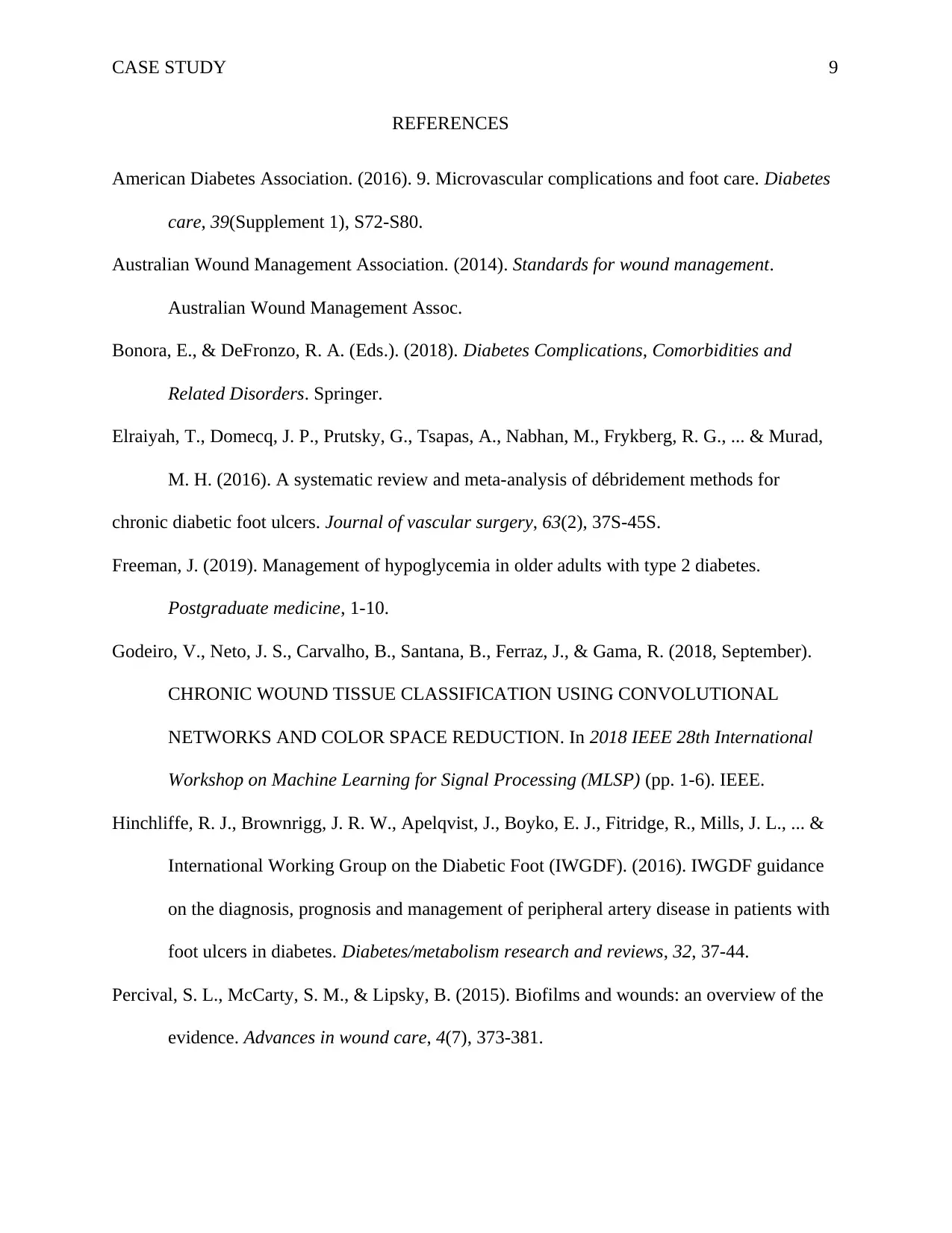
CASE STUDY 9
REFERENCES
American Diabetes Association. (2016). 9. Microvascular complications and foot care. Diabetes
care, 39(Supplement 1), S72-S80.
Australian Wound Management Association. (2014). Standards for wound management.
Australian Wound Management Assoc.
Bonora, E., & DeFronzo, R. A. (Eds.). (2018). Diabetes Complications, Comorbidities and
Related Disorders. Springer.
Elraiyah, T., Domecq, J. P., Prutsky, G., Tsapas, A., Nabhan, M., Frykberg, R. G., ... & Murad,
M. H. (2016). A systematic review and meta-analysis of débridement methods for
chronic diabetic foot ulcers. Journal of vascular surgery, 63(2), 37S-45S.
Freeman, J. (2019). Management of hypoglycemia in older adults with type 2 diabetes.
Postgraduate medicine, 1-10.
Godeiro, V., Neto, J. S., Carvalho, B., Santana, B., Ferraz, J., & Gama, R. (2018, September).
CHRONIC WOUND TISSUE CLASSIFICATION USING CONVOLUTIONAL
NETWORKS AND COLOR SPACE REDUCTION. In 2018 IEEE 28th International
Workshop on Machine Learning for Signal Processing (MLSP) (pp. 1-6). IEEE.
Hinchliffe, R. J., Brownrigg, J. R. W., Apelqvist, J., Boyko, E. J., Fitridge, R., Mills, J. L., ... &
International Working Group on the Diabetic Foot (IWGDF). (2016). IWGDF guidance
on the diagnosis, prognosis and management of peripheral artery disease in patients with
foot ulcers in diabetes. Diabetes/metabolism research and reviews, 32, 37-44.
Percival, S. L., McCarty, S. M., & Lipsky, B. (2015). Biofilms and wounds: an overview of the
evidence. Advances in wound care, 4(7), 373-381.
REFERENCES
American Diabetes Association. (2016). 9. Microvascular complications and foot care. Diabetes
care, 39(Supplement 1), S72-S80.
Australian Wound Management Association. (2014). Standards for wound management.
Australian Wound Management Assoc.
Bonora, E., & DeFronzo, R. A. (Eds.). (2018). Diabetes Complications, Comorbidities and
Related Disorders. Springer.
Elraiyah, T., Domecq, J. P., Prutsky, G., Tsapas, A., Nabhan, M., Frykberg, R. G., ... & Murad,
M. H. (2016). A systematic review and meta-analysis of débridement methods for
chronic diabetic foot ulcers. Journal of vascular surgery, 63(2), 37S-45S.
Freeman, J. (2019). Management of hypoglycemia in older adults with type 2 diabetes.
Postgraduate medicine, 1-10.
Godeiro, V., Neto, J. S., Carvalho, B., Santana, B., Ferraz, J., & Gama, R. (2018, September).
CHRONIC WOUND TISSUE CLASSIFICATION USING CONVOLUTIONAL
NETWORKS AND COLOR SPACE REDUCTION. In 2018 IEEE 28th International
Workshop on Machine Learning for Signal Processing (MLSP) (pp. 1-6). IEEE.
Hinchliffe, R. J., Brownrigg, J. R. W., Apelqvist, J., Boyko, E. J., Fitridge, R., Mills, J. L., ... &
International Working Group on the Diabetic Foot (IWGDF). (2016). IWGDF guidance
on the diagnosis, prognosis and management of peripheral artery disease in patients with
foot ulcers in diabetes. Diabetes/metabolism research and reviews, 32, 37-44.
Percival, S. L., McCarty, S. M., & Lipsky, B. (2015). Biofilms and wounds: an overview of the
evidence. Advances in wound care, 4(7), 373-381.
⊘ This is a preview!⊘
Do you want full access?
Subscribe today to unlock all pages.

Trusted by 1+ million students worldwide
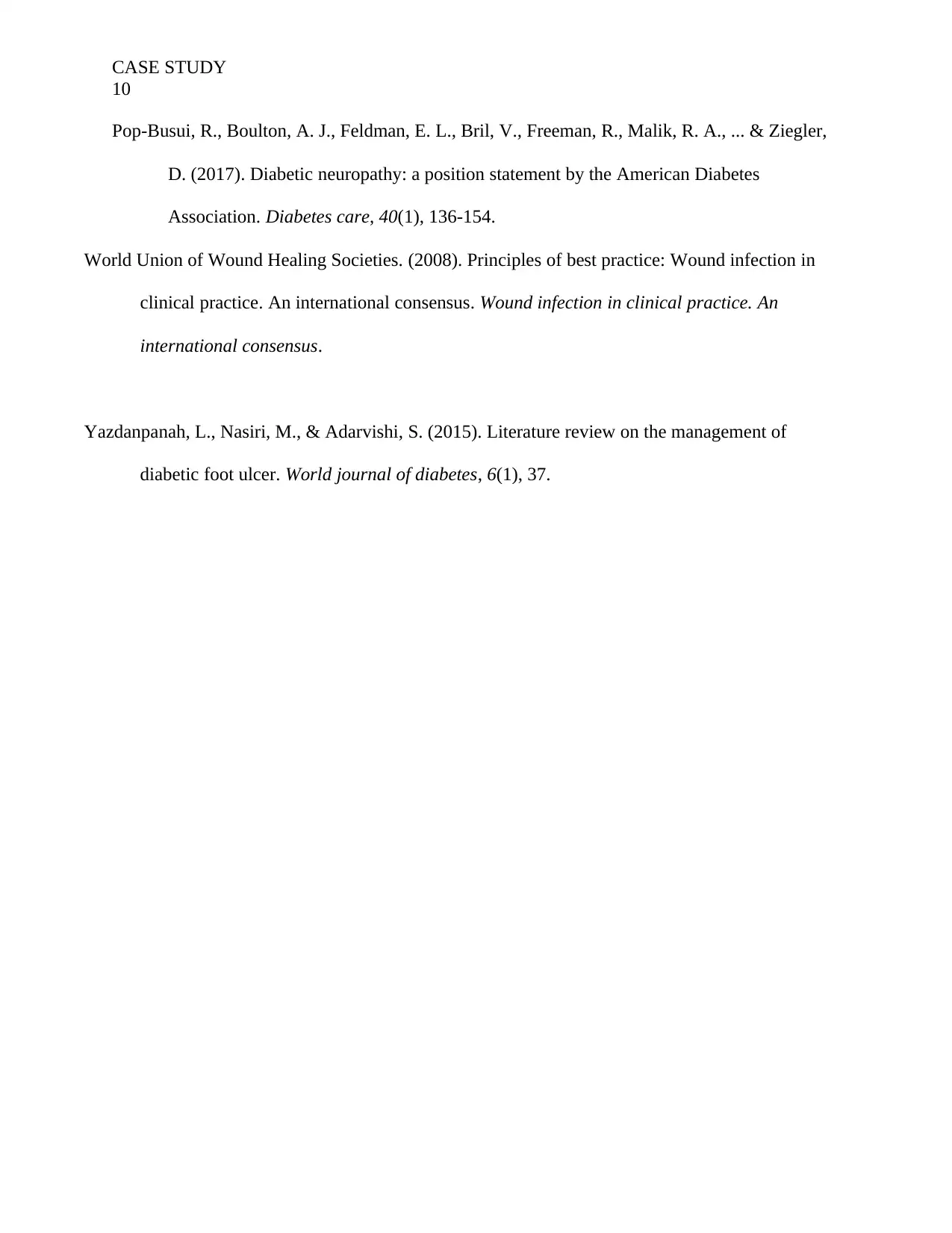
CASE STUDY
10
Pop-Busui, R., Boulton, A. J., Feldman, E. L., Bril, V., Freeman, R., Malik, R. A., ... & Ziegler,
D. (2017). Diabetic neuropathy: a position statement by the American Diabetes
Association. Diabetes care, 40(1), 136-154.
World Union of Wound Healing Societies. (2008). Principles of best practice: Wound infection in
clinical practice. An international consensus. Wound infection in clinical practice. An
international consensus.
Yazdanpanah, L., Nasiri, M., & Adarvishi, S. (2015). Literature review on the management of
diabetic foot ulcer. World journal of diabetes, 6(1), 37.
10
Pop-Busui, R., Boulton, A. J., Feldman, E. L., Bril, V., Freeman, R., Malik, R. A., ... & Ziegler,
D. (2017). Diabetic neuropathy: a position statement by the American Diabetes
Association. Diabetes care, 40(1), 136-154.
World Union of Wound Healing Societies. (2008). Principles of best practice: Wound infection in
clinical practice. An international consensus. Wound infection in clinical practice. An
international consensus.
Yazdanpanah, L., Nasiri, M., & Adarvishi, S. (2015). Literature review on the management of
diabetic foot ulcer. World journal of diabetes, 6(1), 37.
1 out of 10
Related Documents
Your All-in-One AI-Powered Toolkit for Academic Success.
+13062052269
info@desklib.com
Available 24*7 on WhatsApp / Email
![[object Object]](/_next/static/media/star-bottom.7253800d.svg)
Unlock your academic potential
Copyright © 2020–2025 A2Z Services. All Rights Reserved. Developed and managed by ZUCOL.




